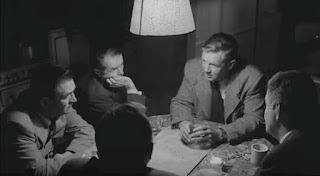When you are committed to give your best shot on something,
how often will that be burnt to ruins due to one minor diversion? This was a
question posed by Stanley Kubrick 60 years ago, through his classic film ‘The
Killing’ (1956)!
‘The Killing’ was a heist film about the planning and
execution of a daring racetrack robbery, orchestrated by a bunch of underdogs
with Johnny Clay (Sterling Hayden) as the leader. The meticulously planned
heist went out well, yet at the end everything was destroyed either by personal
intrigues or, at a darkly ironic twist, fate. I have to say Sterling Hayden was
the perfect choice to star as the dark and cynical character, and of course, in
the 1950s he was also the protagonist in Nicholas Ray’s ‘Johnny Guitar’. Hayden
would appear again as General Jack Ripper in ‘Dr. Strangelove’, who seemed to
have issues with contamination of his country men’s bodily fluids. Indeed, when
Steven Spielberg was casting for ‘Jaws’ (1975), he had Sterling Hayden in mind
as one of the 3 heroes to battle the shark, yet due to circumstances, the role
eventually went to Robert Shaw. ‘The Killing’ was also noted for its non-linear
narrative, which was not that common in the classical Hollywood era, and
Quentin Tarantino has also cited ‘The Killing’ as an important influence on his debut, ‘Reservoir Dogs’
(1992), which was also non-linear in terms of the narrative.
 |
| The gang and the plan. |
One of the most stunning attributes of Kubrick’s oeuvre was
that he has always been able to build on existing genre with his original
touch, and in many case revolutionized the genre in question. This has indeed
been happened since his earliest day, and ‘The Killing’ was a nice example to
illustrate this aspect. ‘The Killing’ belongs to the genre of Film Noir, for
which some commentators may consider that more as a style than a category of
film. A strong sense of formalism can be easily spotted in a Film Noir, and
Kubrick has made no intention to overturn the table here. Yet, he has included
‘Kubrickian’ elements into his brave attempt at the established genre, and what
resulted was an original masterpiece that was very different in tone when
compared to the other filmmakers of the day.
 |
| Wrong person at the wrong place? |
The heist or robbery scenario, which was often
termed a caper, was a very popular theme in many of the Film Noir, especially
in the early 1950s. Examples ranged from John Huston’s ‘The Asphalt Jungle’ to
Jules Dassin’s ‘Rififi’ and Jean-Pierre Melville’s ‘Bob le flambeur’, and many
other examples followed. The heist film in the 1950s tended to follow a certain
formula – which usually involved a technically-brilliant and well-planned robbery plan, the successful
execution of the crime, and often ended in a tragic way due to some humanistic
factors – such as greed or betrayal. It seems that a dark ending is a necessary
requirement for many of these heist films, and I have often wondered is this a
morality concern or just an illustration of a pessimistic worldview?
 |
| Causing trouble or distraction? |
Since these heist films could be considered as Film Noir,
they often followed the standard style of the
Noir-ish films. From a
high-contrast / low key lighting scheme to the claustrophobic composition, from
the depth in composition to suggest intrigue, and the chiaroscuro lighting
pattern, these motifs all illustrate the ‘underdog’ status of these petty criminals
and the status as the prisoners of their fate. Heist films are particularly
good source for Film Noir because they also stressed the paranoia inherent in
all of us. The worries that things will go wrong, and the prejudice and
distrust exhibited towards the other members are often the factors that will
screw up the ambitious train of fame these criminals plan to ride on.
 |
| To shoot or be shot? |
In ‘The Killing’, Kubrick has adopted the aforementioned motifs
so characteristic in the genre of Film Noir, and at the same time instilled his
original touch to the film. Some of the techniques and motifs that would appear
again and again in his later films gave their first appearance here, and it was
also worthwhile to note that more experimental and non-Kubrickian techniques
have also been employed. For example, the shots in the film were comparably
shorter and faster cuts than his later work, which was characterized often by
very protracted tracking shots and deliberate pacing. The shorter average shot
length (ASL) in ‘The Killing’ was more akin to the style of Sergei M.
Eisenstein and the other Russian montage pioneers, for which Kubrick has been
fascinated and inspired by at the early stage of his career. Nevertheless,
there were also evidences that Kubrick was experimenting sparingly with fluid
tracking shot, which was most likely influenced by Max Ophuls’ ‘Lola Montes’
and his earlier work. The shorter cut
might also contribute to a more fragmented perspective experienced by the
audience from the film, where the key characters were giving the own viewpoint on
the heist and the matters related to that. Furthermore, the non-chronological
narrative disoriented the viewer and increased the paranoia and uncertainty
that could be experienced by the viewers, captivating the audience’s attention
at the same time.
 |
| Solo performance - Johnny Clay's hold-up of the racetrack cashier. |
(1/2)
by Ed Law
18/6/2016
Film Analysis - 66




